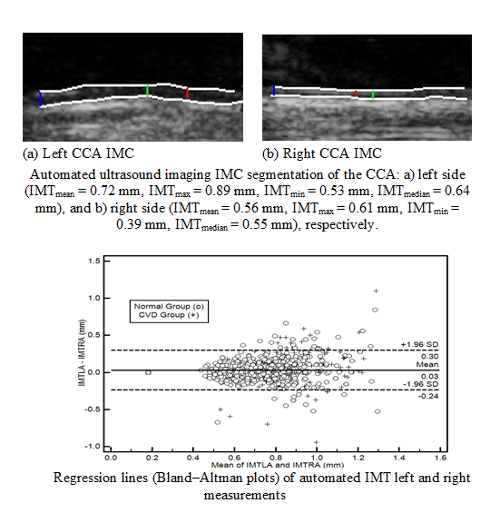
The intima–media thickness (IMT) of the common carotid artery (CCA) is an established indicator of cardiovascular disease (CVD). There have been reports about the difference between the left and the right sides of the CCA IMT and their relation with cardiovascular disease. In this study, we propose an automated system based on image normalisation, speckle reduction filtering and snakes segmentation, for segmenting the CCA, perform IMT measurements and provide the differences between the left and right sides. The study was performed on 1104 longitudinal-section ultrasound images acquired from 568 men and 536 women out of which 125 had cardiovascular symptoms (CVD). A cardiovascular expert manually delineated the IMT for the normal and the CVD groups. The corresponding (normal vs CVD) IMT mean ± standard deviation values for the left and right sides were 0.74±0.24 vs 0.87±0.24 mm and 0.70±0.17 vs 0.80±0.18 mm respectively. The main findings of this study can be summarised as follows: (1) there was no significant difference between the CCA left side IMT and the right side IMT. These findings suggest that the measurement of the CCA IMT on one side only is needed for the normal group (and this is in agreement with other studies); (2) there were statistical significant differences for the IMT measurements between the normal group and the CVD group for both the left and the right sides; (3) there was an increasing linear relationship of the left and right IMT measurements with age for the normal group; and to a lesser extend for the CVD group; (4) no statistical significant differences were found between the manual and the automated IMT measurements for both sides; (5) the best result for classification disease modelling, using support vector machines (SVM), to discriminate between the normal and the CVD groups was a 64±3.5% correct classifications score when using both the left and the right IMT automated measurements. Further research is required for estimating differences and similarities between left and right intima media complex structure and morphology and their variability with texture features for differentiating between the normal and the cardiovascular disease group.

